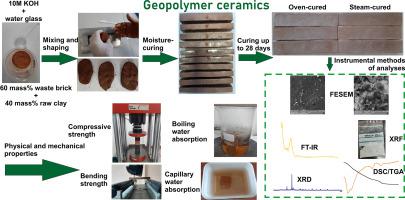Applied Clay Science ( IF 5.3 ) Pub Date : 2022-01-13 , DOI: 10.1016/j.clay.2022.106410 Milica Vidak Vasić 1 , Anja Terzić 1 , Željko Radovanović 2 , Zagorka Radojević 1 , Laurence N. Warr 3

|
Geopolymerization was investigated as an alternative to traditional ceramic products by developing a more sustainable approach that avoids thermal treatment. The study presents the first known alkali-activation of the raw clay and waste clay brick mixture using the solid to liquid ratios of 2.33 and 2.78. Several experimental sets were prepared to harden under varying conditions (2–4 days drying in 60 °C–70 °C and 3 h steam-curing). Non-activated and activated samples were analyzed for their physical and chemical properties after 14, 21, and 28 days. The tile-shaped specimens exhibited better initial drying behavior than the cubes and produced stronger materials with fewer cracks. Pre-curing in steam conditions induced higher flexural strength (13.7 MPa) and water absorption (13.13%) for the geopolymer tiles. The highest Si/Al molar ratio in the amorphous portion of 5.78 induced the best flexural strength. The geopolymerization process showed microstructural changes associated with the appearance of fibrous Na-zeolite nanocrystals. The degree of geopolymerization and zeolite formation was enhanced by steam-curing, but the microstructural stress and heterogeneity induced by the reactions resulted in higher water absorption. Ongoing reactions of amorphization in the bulk material and further crystallization at the surface are documented after 6 months of curing. This first detailed study reveals that the production of geopolymer ceramics from brick waste is possible, but further optimization of the activating solution and curing parameters is required.
中文翻译:

低伊利石生粘土和废砖混合物的碱活化地质聚合。传统陶瓷的替代品
通过开发一种避免热处理的更可持续的方法,研究了地质聚合作为传统陶瓷产品的替代品。该研究首次提出了使用 2.33 和 2.78 的固液比对生粘土和废粘土砖混合物进行碱活化。准备了几个实验装置以在不同的条件下硬化(在 60°C-70°C 中干燥 2-4 天,蒸汽固化 3 小时)。在 14、21 和 28 天后分析未活化和活化样品的物理和化学性质。瓦形试样表现出比立方体更好的初始干燥行为,并且产生的材料更坚固,裂缝更少。在蒸汽条件下进行预固化可使地质聚合物瓷砖具有更高的抗弯强度 (13.7 MPa) 和吸水率 (13.13%)。在 5.78 的非晶部分中最高的 Si/Al 摩尔比产生了最好的抗弯强度。地质聚合过程显示出与纤维状 Na-沸石纳米晶体的外观相关的微观结构变化。蒸汽固化提高了地质聚合和沸石形成的程度,但反应引起的微观结构应力和异质性导致更高的吸水率。固化 6 个月后,记录了散装材料中的非晶化和表面进一步结晶的持续反应。第一项详细研究表明,用砖废料生产地质聚合物陶瓷是可能的,但需要进一步优化活化溶液和固化参数。地质聚合过程显示出与纤维状 Na-沸石纳米晶体的外观相关的微观结构变化。蒸汽固化提高了地质聚合和沸石形成的程度,但反应引起的微观结构应力和异质性导致更高的吸水率。固化 6 个月后,记录了散装材料中的非晶化和表面进一步结晶的持续反应。第一项详细研究表明,用砖废料生产地质聚合物陶瓷是可能的,但需要进一步优化活化溶液和固化参数。地质聚合过程显示出与纤维状 Na-沸石纳米晶体的外观相关的微观结构变化。蒸汽固化提高了地质聚合和沸石形成的程度,但反应引起的微观结构应力和异质性导致更高的吸水率。固化 6 个月后,记录了散装材料中的非晶化和表面进一步结晶的持续反应。第一项详细研究表明,用砖废料生产地质聚合物陶瓷是可能的,但需要进一步优化活化溶液和固化参数。但由反应引起的微观结构应力和异质性导致更高的吸水率。固化 6 个月后,记录了散装材料中的非晶化和表面进一步结晶的持续反应。第一项详细研究表明,用砖废料生产地质聚合物陶瓷是可能的,但需要进一步优化活化溶液和固化参数。但由反应引起的微观结构应力和异质性导致更高的吸水率。固化 6 个月后,记录了散装材料中的非晶化和表面进一步结晶的持续反应。第一项详细研究表明,用砖废料生产地质聚合物陶瓷是可能的,但需要进一步优化活化溶液和固化参数。


















































 京公网安备 11010802027423号
京公网安备 11010802027423号